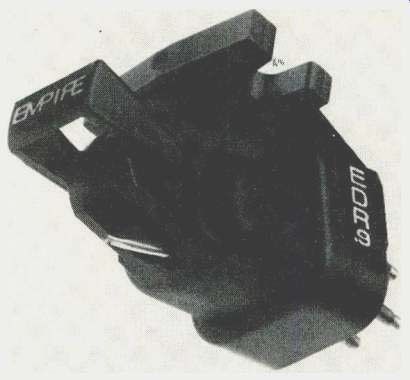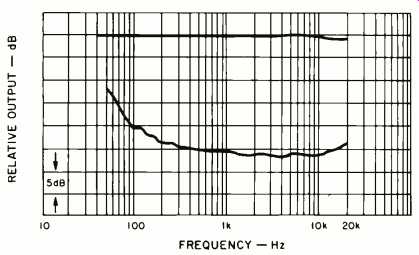
Manufacturer's Specifications:
Frequency Response: 10 - 50,000 Hz; 20 - 35,000 Hz ± 1.75 dB.
Recommended Tracking Force: 0.75 to 1.25 grams.
Separation: 20 Hz to 500 Hz, 20 dB; 500 Hz to 15 kHz, 30 dB, and 15 kHz to 20 kHz, 20 dB.
IM Distortion: 0.08 percent, 2 kHz to 20 kHz at 3.54 cm/sec.
Stylus: L.A.C. radii, 0.3 x 3.0 mil.
Effective Tip Mass: 0.30 mG.
Compliance: 28 x 10^-6 cm/dyne.
Tracking Ability: 38 cm/sec at 1 kHz at 0.9 grams.
Channel Balance: 0.75 dB at 1 kHz.
Inductance: 250 mH.
D.C. Resistance: 650 Ohms.
Input Load: 47 kilohms.
Total Capacitance: 100 pF.
Output: 4.5 mV at 5 cm/sec.
Vertical Tracking Angle: 20 degrees.
Type of Cartridge: Moving iron, variable reluctance.
Weight: 5.2 grams.
Stylus Replacement: S5000.
Price: $200.00.
Empire Scientific recently introduced a totally new phono cartridge, the EDR.9, which is the new top of their phono cartridge line. Its design incorporates an L.A.C. (large Area Contact) stylus which is said to have a smaller radius and larger contact area than any other cartridge. The 0.3x3.0-mil stylus radii does fit comfortably within the high frequency portion of the record groove and has a very large, low-pres sure contact area between the stylus and groove, and thus should give remarkably good record wear. A recent EIA paper, RS-238B, on stylus pressure index calculation, shows that higher indexes should give better tracking, lower distortion, and a lighter tracking pressure unit area for good wear.
The EDR.9 rates high in this regard, and the diamond stylus is polished and mounted "nude" to further reduce tip mass.
The hollow aluminum cantilever, which is tapered from base to tip, thus achieving greater rigidity while decreasing tip mass, contains a miniature iron bar that behaves like a tuning fork, moving only in a specific range of frequencies and operating as an inertial damper of the high frequency response peak that usually appears due to elastomer-cantilever resonance. This inertially dampened "tuned stylus" system thus acts as a sort of mechanical equalizer to eliminate the elastomer-cantilever resonance.
To reduce the mass of the stylus assembly and, hence, improve transient performance and tracking, the EDR.9 design is of the variable reluctance type, utilizing a lightweight, hollow ferrous tube, rather than relatively heavy magnets, attached to its cantilever. The electrical elements of the EDR.9 have been designed to remain unaffected by any normal variation in load capacitance. The name EDR.9 is derived from "Extended Dynamic Response" and the ".9" indicates the pressure index of the stylus.
Measurements
The Empire EDR.9 phono cartridge was mounted on a Technics lightweight, aluminum alloy, die-cast head shell which contains a vibration-proof viscous-elastic material to provide non-resonant performance. The head shell total weight is 9.5 grams. The mounted cartridge was used with the Technics EPA-100 universal tonearm, mounted on the Technics SP-10 Mk2 turntable.

Fig. 1--Frequency and separation using the CBS STR-170 test disc.

Fig. 2--Response to a 1-kHz square wave.
To obtain near-perfect cartridge/stylus lateral alignment (to better than 0.003") and optimum tracing of the record groove, we oriented the Empire EDR.9 cartridge in its shell and tonearm using our latest tool, the Dennesen Geometric Soundtracktor ( Box 51, Beverly, Mass. 01915). This stylus alignment tool compensates for any errors made in the tonearm design and manufacture, automatically setting the appropriate overhang for any pivoted tonearm effective length.
The cartridge was loaded with 47 kilohms resistance in parallel with 100 pF capacitance for all measurements. The measurements were made at a tracking force of 1.25 grams. During the test period, the average temperature was 76°F (24.44° C) and the relative humidity 68 percent ±3 percent.
Frequency response, using the Columbia STR-170 test record, is flat from 40 Hz to 20 kHz within +0.33 dB to -1.6 dB. Specifically, the response is within +0.33 dB from 40 Hz to 9 kHz, then slowly descends to -1.6 dB from 14 to 20 kHz.
Separation is 25.6 dB at 1 kHz, 27 dB at 10 kHz, 23.5 dB at 15 kHz, and 22 dB at 20 kHz. The separation between 10 and 20 kHz is excellent, a good deal better than that found in most cartridges.
The response to a 1-kHz square wave shows a moderate overshoot followed by ringing that decays moderately fast, with a stylus resonance at about 38 kHz. The cartridge-arm low-frequency resonance was of 1.25 dB amplitude at 7.5 Hz and of 1 dB amplitude at 8.5 Hz. When utilizing the dynamic damping system present on the Technics EPA-100 universal tonearm, the cartridge-arm low-frequency resonance was at 7.5 Hz and of 0.75 dB amplitude, and at 8.75 Hz with an amplitude of 0.5 dB.
The following test records were used in making the reported measurements:
Micro-Acoustics TT-2002; Shure TTR-103, TTR-109, TTR-110, TTR-115; Columbia STR-170, STR-100, STR 112, SQT-1100; Deutsches HiFi No. 2, and the Nippon Columbia Audio Technical Record (PCM) XL-7004.
Wt. 5.2 gm; d.c. resistance 663 ohms; inductance 276 mH; tracking force 1.25 grams; opt. anti-skating force 1.5 grams; output 0.99 mV/cm/sec; IM distortion (4:1) + 9 dB lateral, 200/4000 1.9 percent, + 6 dB vertical, 200/4000 6.4 percent; crosstalk (using Shure TTR-109) greater than 30 dB; channel balance within 1 dB; trackability: high freq. (10.8 kHz pulsed) 24 cm/sec, mid-freq. (1000 + 1500 Hz, lat. cut) 31.5 cm/sec, low freq. (400 + 4000 Hz, lat. cut) 24 cm/sec; Deutsches HiFi No. 2 300-Hz test band was tracked cleanly to 86 microns (0.0086 cm), lateral at 16.20 cm/sec at +9.66 dB and 32.6 microns (0.00326 cm), vertical at 6.17 cm/sec and +1.19 dB.
The Empire EDR.9 cartridge was able to play all the tracking and transient ability bands of the Micro-Acoustics TT-2002 musical test record without difficulty. All instruments were easily localized without any smearing of position. Applause definition was very good. The Shure Obstacle Course - Era III test record was played without difficulty except towards the end of band 5 of the violin test where a very slight mistracking was heard. With the newer Shure Obstacle Course--Era IV test record's orchestral bell test, level 5, the cartridge just started to mis-track on the initial transients.
Level 5 of the harp-and-flute test had a hint of mistracking in the difference tones, while level 5 of the flute and orchestral bells test sounded muddied in the difference tones. Only very rarely is a cartridge capable of playing all levels of these test records without mistracking one or more of the high level bands.
Listening and Use Tests
As is our practice, extensive listening tests were performed both before and after laboratory testing of the Empire EDR.9 phono cartridge. While listening to the wide variety of re cords listed below, we specially noted the excellent sonic clarity and lack of detectable coloration, particularly when reproducing the high recorded levels present on most current direct-to-disc recordings, such as those listed below. The Empire EDR.9 is truly a "musical" cartridge, and it is very pleasing to the ear when playing music. In conclusion, this new top-of-the-line phono cartridge should be considered as an excellent choice for most every music system.
--B.V. Pisha
--- ------- ---
Evaluation Equipment and Records
A rigorous listening evaluation was performed on the EDR.9 using the following equipment and the specific records listed below. The equipment included the Technics SP-10 Mk 2 turntable fitted with their EPA-100 universal tonearm, Crown IC-150A preamplifier, a pair of Crown DC-300A amplifiers used in monophonic mode, a pair of stacked Duntech DL-15 speakers in each channel, and a Columbia SQL-400A SQ decoder. Each pair of speakers were connected to the amplifiers with Polk Sound Cables using the Polk RC terminating networks at the speaker end of each cable. The turntable was equipped with the Hiraoko Disc-SE22 turn table mat. The following records were used to aurally evaluate the performance of the Empire EDR.9 phono cartridge:
Stereo
Pink Floyd: The Dark Side of the Moon--Mobile Fidelity Sound Lab MFSL 1-017.
Puccini: Prelude Sinfonico, Capriccio Sinfonico, Edgar: Preludio, Mercadante: Sinfonia, Boito: Sinfonia en la Mineur, Verdi: La Battaglia di Legnano, Sci mone, Orchestre National de L'Opera de Monte-Carlo--Erato on RCA STU 71040.
Ormandy conducts Wagner (excerpts) Vol. 2: Parsifal, Tristan and Isolde, The Flying Dutchman, The Philadelphia Orchestra--RCA ARL1-2528.
Mehta conducts Schubert: Symphonies No. 4 (Tragic) and No. 8 (Unfinished), The Israel Philharmonic Orchestra--London CS 7067.
Montemezzi: L'Amore dei Tre Re (Moffo and Domingo), Santi, London Sym phony Orchestra--RCA ARL2, 1945.
Direct to Disc
Gould Conducts Gould: Spirituals for Orchestra and Foster Gallery, The Lon don Philharmonic Orchestra-Crystal Clear Records CCS 7005.
Walter Susskind Conducting the London Philharmonic Orchestra--Crystal Clear Records CCS 7006.
George Wright Plays the Chicago Theatre Organ, Vol. 2--Century Records CR 1061. P114h 315,1101061.
Robert Wagner Chorale: Encore- M & K Realtime Records RT 110.
Dixie Direct featuring Rosie O'Grady's Good Time Jazz Band--Direct Disk Records DD103.
Nostalgia Suite, Roger Kellaway and the Cello Quintet--Discwasher Recordings DR 003 DD.
This is Creation Studio Live in Direct-to-Disc Recording- Express (Toshiba-EMI Ltd) ELF-95024.
Pulse Code Modulation (PCM)
Bizet: L'Arlesienne Suite, Carmen Suite, Miedel, Yomiuri Nippon Symphony Orchestra--Denon OX-7153-ND (Denon records are distributed by American Audioport, Inc.).
Midnight Over Memphis, John Stubblefield--Denon YX-7546-ND.
Together, Tommy Flanagan & Kenny Barron--Denon YX-7544-ND.
Fantasia, Hilton Ruiz--Denon YX-7548-ND.
The 24th Street Band- Denon YX-7547-ND.
Joplin: "Bethena" and other Ragtime Music- Denon OX-7158-ND.
Dvorak: String Quartet No. 12(6) in F Major, Quintet in A Major for Piano and Strings, Smetana Quartet--Denon OX-7152-N D.
Concert pour Ensemble de Koto--Debussy et Ravel, Keiko Nosaka et son ecole--Denon OX-7155-ND.
Digital to Analog
New Year's in Vienna, Boskovsky, The Vienna Philharmonic-- London Digital Recording LDR 10001-2.
Shostakovich: Festive Overture, Ravel: Bolero, Ginastera: Estancia Ballet Suite, Weinberger: Polka and Fugue from "Schwanda," Gould, London Symphony Orchestra--Chalfonte SDG 301.
Macho Marches, Fennell, The Cleveland Symphonic Winds--Telarc DG-10043.
Quadraphonic--SQ
Rated Extraordinaire, Johnnie Taylor- Columbia PCQ 34401.
The Miracles, Love Crazy-Columbia PCQ 34460.
(Audio magazine, Sept. 1979)
Also see:
Empire 600 LAC Phono Cartridge (Jun. 1982)
Empire Scientific EDR.9 phono cartridge (ad, Sept. 1979)
Empire Scientific phono cartridges (ad, Nov. 1978)
Empire Model 698 Turntable (Dec. 1977)
= = = =